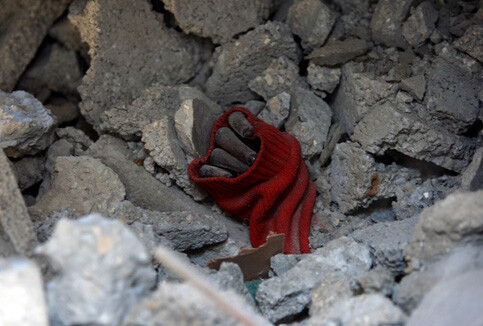The Electronic Intifada 21 January 2009

The hand of a girl from the Samuni family buried under the rubble of her house in the al-Zeitoun neighborhood of Gaza City, 18 January 2009. (Wissam Nassar/MaanImages)
GAZA CITY, occupied Gaza Strip (IPS) - A pillow, a belt, a child’s school bag and pages of a torn copy of the Quran lie in the wreckage of the al-Daa family home in al-Zeitoun, a neighborhood of Gaza City. Twenty-four members of the family were killed when an F-16 fighter jet dropped a bomb on their house. Nine bodies still lie under what is now just a massive pancake of concrete, metal wires and death.
“There were no Hamas fighters here,” said Zohair al-Raay, a neighbor of the al-Daa family. “Where are the weapons? Where are the missiles? The al-Daa family had nothing to do with that.”
Eyad al-Daa, father of 32, was found clutching three small children in the stairwell.
As the ceasefire continues to hold, the sheer scale of the destruction in the Gaza Strip is finally emerging. The deadly, three-week assault by Israel has been devastating.
Generations of families are vanished, and entire villages now destroyed. Many of the dead are still buried beneath the rubble, their neighbors and relatives left with no way to retrieve them.
In one of the most harrowing incidents, 35 members of the Samuni family were killed in al-Zeitoun by an F-16. The surviving members dug the bodies out on Sunday, the first day of the ceasefire.
At least 5,000 houses have been destroyed and 20,000 buildings damaged throughout the strip, according to local officials. The Gaza Strip is just 40 kilometers long and 10 kilometers wide.
Twenty mosques and 16 ministry offices were destroyed, with at least 200 million dollars worth of damage to local infrastructure. The face of the al-Quds Hospital is scorched from tank fire, and Gaza City is still without power.
On Tuesday, in the northern Gaza City neighborhood of al-Attatra, almost entirely demolished and laced with tank treads, the body of a 94-year-old woman was pulled from the wreckage by her son. The Israeli army shot and killed her, he says, before they brought the house down, again with an F-16.
“What did she have to do with rockets being fired into Israel?” he asked. The family had been looking for her for days.
Such stories are commonplace in Gaza since Israel unleashed its deadly war on the territory on 27 December.
More than 1,300 Palestinians have been killed in the past three weeks, a third of them children, according to both Gaza health officials and the United Nations. Some 5,500 people have been injured.
According to the civil defense force in Gaza, which has been tasked with helping pull bodies from the debris, there are still up to 200 persons missing in the northern areas of Gaza. They are presumed dead.
“This is the worst violence we have seen since the Nakba,” says 75-year-old Ibrahim Mohamed Hindi of al-Zeitoun, using the Arabic word for “catastrophe” to refer to the displacement of hundreds of thousands of Palestinians and the creation of Israel in 1948.
What is also alarming is the apparent vicious nature of the destruction, locals are saying.
Khamis Mohamed al-Atar and several other members of his family were forcibly removed from their home in al-Attatra and taken to a prison in the Negev for 15 days while Israeli soldiers occupied the house, which sits on a hill overlooking Gaza City, the strip’s major population center.
“One soldier brought me outside and another came out and asked the first one where the rest of my family was,” Mohamed al-Atar said. “Then he suggested to the soldier that they bring us all outside, line us up against the wall and shoot us. He said they didn’t care which houses had people in them. I thought they were going to kill us all.”
When Mohamed al-Atar returned, he found the body of his son left rotting among the family’s now decimated orange groves. He had been shot.
The inside of their house was smeared with graffiti in Hebrew. The Star of David, an icon of both the Jewish faith and the Israeli state, was spray-painted on the hallways. The toilets had been blasted with grenades, and the floor was blanketed with Israeli food wrappers and bullet shells.
In a farming area near Beit Hanoun cows lie dead across an entire field, some ripped open by shrapnel and others simply crushed by tanks. The corpses of donkeys, horses, goats and chickens line the streets.
“This is my family’s livelihood,” said Youssef, 18, of his farm’s slaughtered animals. “And now it’s gone. Who would take the time to kill cows in this war?”
In the same area, residents found a type of weapon that sends a throng of nails as far as the size of a football field in each direction, according to an Amnesty International representative investigating its use in Gaza.
A resident, father of an ambulance driver killed by a drone missile on 5 January, pointed to nails lodged in the side of his house. He said the Israeli army used the weapon on them during his son’s funeral procession.
“I don’t have any feelings any more,” said Mohamed Hindi. “The Israelis have managed to destroy everything. Even our emotions.”
All rights reserved, IPS - Inter Press Service (2009). Total or partial publication, retransmission or sale forbidden. Jim Lobe in Washington contributed to this article.
Related Links



